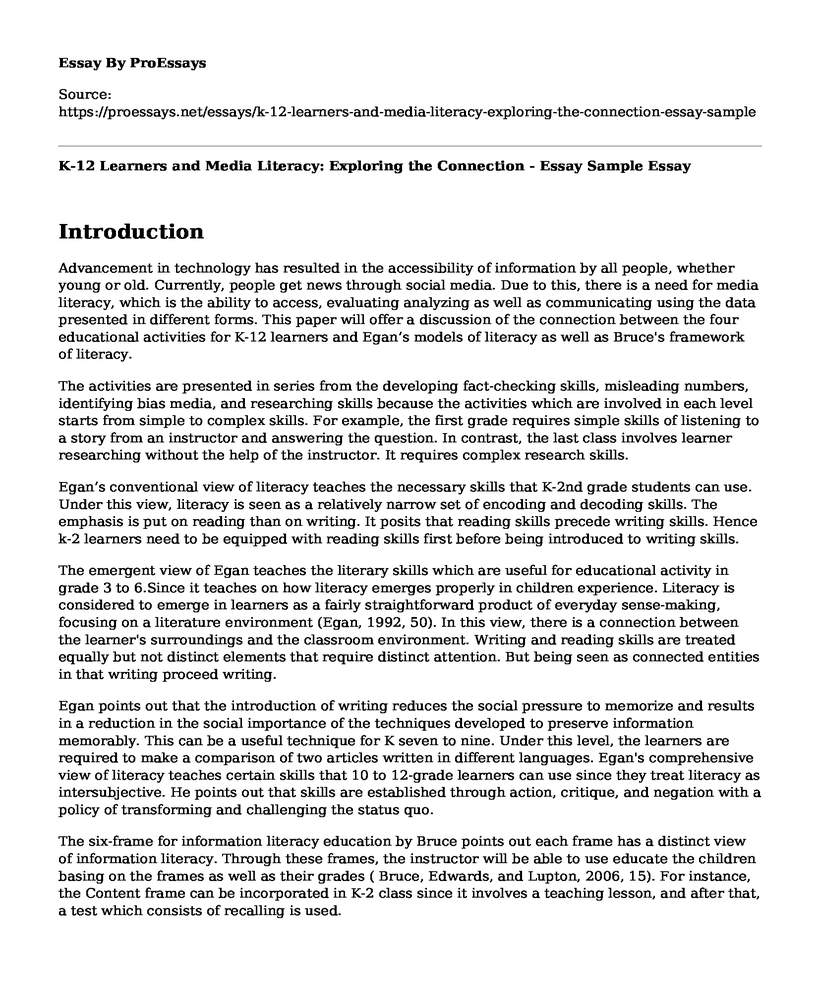Introduction
Advancement in technology has resulted in the accessibility of information by all people, whether young or old. Currently, people get news through social media. Due to this, there is a need for media literacy, which is the ability to access, evaluating analyzing as well as communicating using the data presented in different forms. This paper will offer a discussion of the connection between the four educational activities for K-12 learners and Egan’s models of literacy as well as Bruce's framework of literacy.
The activities are presented in series from the developing fact-checking skills, misleading numbers, identifying bias media, and researching skills because the activities which are involved in each level starts from simple to complex skills. For example, the first grade requires simple skills of listening to a story from an instructor and answering the question. In contrast, the last class involves learner researching without the help of the instructor. It requires complex research skills.
Egan’s conventional view of literacy teaches the necessary skills that K-2nd grade students can use. Under this view, literacy is seen as a relatively narrow set of encoding and decoding skills. The emphasis is put on reading than on writing. It posits that reading skills precede writing skills. Hence k-2 learners need to be equipped with reading skills first before being introduced to writing skills.
The emergent view of Egan teaches the literary skills which are useful for educational activity in grade 3 to 6.Since it teaches on how literacy emerges properly in children experience. Literacy is considered to emerge in learners as a fairly straightforward product of everyday sense-making, focusing on a literature environment (Egan, 1992, 50). In this view, there is a connection between the learner's surroundings and the classroom environment. Writing and reading skills are treated equally but not distinct elements that require distinct attention. But being seen as connected entities in that writing proceed writing.
Egan points out that the introduction of writing reduces the social pressure to memorize and results in a reduction in the social importance of the techniques developed to preserve information memorably. This can be a useful technique for K seven to nine. Under this level, the learners are required to make a comparison of two articles written in different languages. Egan's comprehensive view of literacy teaches certain skills that 10 to 12-grade learners can use since they treat literacy as intersubjective. He points out that skills are established through action, critique, and negation with a policy of transforming and challenging the status quo.
The six-frame for information literacy education by Bruce points out each frame has a distinct view of information literacy. Through these frames, the instructor will be able to use educate the children basing on the frames as well as their grades ( Bruce, Edwards, and Lupton, 2006, 15). For instance, the Content frame can be incorporated in K-2 class since it involves a teaching lesson, and after that, a test which consists of recalling is used.
The competency frame reflects a performance strategy where learners in middle grades are gauged based on their ability to undertake specific tasks using electronic devices. The social impact frame reflects a transformational approach that is how learners in higher grades can impact their surroundings. Such as assessment of learners in terms of hoe information literacy could influence the social challenge.
Bibliography
Bruce, C., Edwards, S., and Lupton, M., 2006. Six Frames for Information literacy Education: a conceptual framework for interpreting the relationships between theory and practice. Innovation in Teaching and Learning in Information and Computer Sciences, 5(1), pp.1-18.
Egan, K., 1992. Romantic understanding: The development of rationality and imagination, ages 8-15. pp. 40-86
Whitworth, A., McIndoe, S., and Whitworth, C., 2011. Teaching media and information literacy to postgraduate researchers. Innovation in Teaching and Learning in Information and Computer Sciences, 10(1), pp.35-42.
Cite this page
K-12 Learners and Media Literacy: Exploring the Connection - Essay Sample. (2023, Aug 02). Retrieved from https://proessays.net/essays/k-12-learners-and-media-literacy-exploring-the-connection-essay-sample
If you are the original author of this essay and no longer wish to have it published on the ProEssays website, please click below to request its removal:
- Rhetorical Analysis of Titanic Movie
- Solar Smashes Wind Energy in the 1st German Technology Tender Essay
- Article Analysis Essay on Impact of Knowledge Management on the Activation of E-Commerce Using Social Media
- Discharged for Off-Duty Behavior Paper Example
- Essay on Genre Theory: A Strategic Study of Films & Audience Engagement
- Girls Like Girls: Hayley Kiyoko's Dance-Pop Anthem for LGBT Community
- Paper Example on Mobile Tech: Revolutionizing Communication in Science







